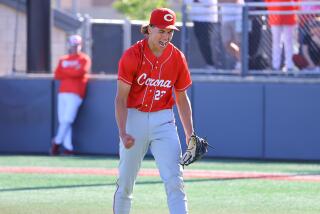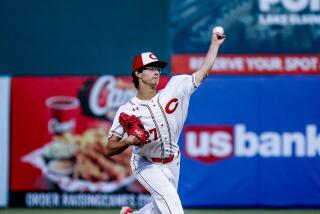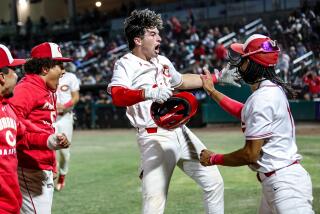Hitters Sacrifice Points With Wooden Bats : Baseball: Batting averages inflate with more cost-efficient aluminum, which is less-pleasing aesthetically.
In the six doubleheaders in which former Schurr High catcher Tony Nieto has gone to the plate with a wooden bat, he has learned to appreciate hitting the way it used to be.
“The crack of that bat on the ball. That sound is awesome,” said Nieto, who this summer plays for the California Seals of the experimental Los Angeles Basin Collegiate League.
Last spring at USC, where he was a freshman, Nieto was accustomed to the pinging sound of rawhide baseballs struck by aluminum bats.
Because they seldom break, aluminum bats have been used almost exclusively in amateur baseball leagues for nearly 20 years. But the eight-team Basin League, headed by Bill Singer, a former pitcher for the Dodgers and Angels, sends hitters to the plate with what some call “a piece of lumber.”
The Basin League is modeled after similar leagues in Cape Cod, Mass., and Alaska, where professional scouts flock each summer to evaluate how quickly potential major leaguers adapt to hitting with softer, brittle, wooden bats.
“This provides scouts with a real good view of kids,” Singer said. “A lot of times it is hard for scouts to judge a kid in a league (with aluminum bats).”
Of 13 leagues sanctioned by the National Baseball Congress of Wichita, Kan., eight use wooden bats, according to Lance Deckinger, the organization’s coordinator of national development. The Basin League, the only wood-bat league on the West Coast, expects to receive NBC sanctioning soon.
However, Deckinger warned: “I don’t see (leagues like this) expanding much more. It’s just too expensive to have wooden bats.”
Singer says the Basin League will spend between $10,000 and $12,000 for the seven-week season just to replace broken bats, which cost about $30 each. Each team began the season with six dozen bats, but Singer admits that is not enough to finish the 28-game season. Players may be supplying their own soon.
Aluminum bats have more economic appeal. They often cost as much as $125, but have staying power. It’s not uncommon for a player to use the same aluminum bat throughout an entire collegiate career.
Today’s players, like Nieto, 19, were just toddlers in 1973, when colleges and high schools replaced wooden bats with metal counterparts. The move inflated batting and earned-run averages alike.
“Aluminum bats add 30 or 40 points to a batting average,” said Seals Coach Paul (Pops) Ivanovsky of Torrance. Ground balls that would die on the grass when struck by wooden bats, which have a smaller sweet spot, often sneak through the infield when hit by aluminum bats, which provide more uniform strength around the barrel.
Singer, who won 20 games with the Dodgers in 1969 and again for the Angels in 1973, said that in the first two weeks of play, Basin League games averaged only 3.5 runs. Batting averages are lower and fielding averages appear to be higher.
“With wood you can’t hit the ball so hard,” Singer said, “so fielding percentages go up. It’s a big adjustment for the kids. Pitchers throw inside more, and the sweet spot on the bats is smaller, so (hitters) need to increase their bat speed.”
Still, Pops Ivanovsky, a minor league player who was recalled in 1967 for a brief stay with the San Francisco Giants, has been an advocate of the creation of a wood-bat league for years. He still has the bat with which he hit a 500-foot home run at Candlestick Park.
“This league has been a lot of fun, and it has been well received,” he said. “We could have had 10 teams this summer if we could have found the coaches.”
The Seals play their games at Long Beach City College. Other franchises are in Ontario, San Bernardino, San Diego, Orange County, Riverside and the San Fernando Valley. Rosters are composed mainly of collegiate players who live within driving distance of home fields, although the San Bernardino Indians recruit players from all over the nation.
“If kids have to go away to play baseball, they can’t continue school,” said Ivanovsky, a longtime proponent of better graduation rates for athletes. “In this league, the (local) kids can stay home or go to summer school or work. If they stay in their own area, they have a better shot at graduation.”
The league, which plays doubleheaders every Saturday and Sunday, also showcases players who have graduated but have not been drafted by major league clubs. Former El Rancho High pitcher Ab Pinon, who set a school record with 21 career victories at Cal State Los Angeles, is one of them.
“It’s more fun as a pitcher in this wood-bat league because there are no chinky hits like there are with aluminum bats,” he said. “I enjoy when I get the chance to break a hitter’s bat.”
Rhode Island pitcher Stephen Birkett, one of the few starters on the Seals who is not from Southern California, came west after playing in the Cape Cod League last year.
Birkett, who hopes to earn a professional contract with his performance this summer, is convinced that wooden bats change the game.
“With wooden bats the distance the ball travels is shorter. Infielders have a chance to react because the balls aren’t hit as fast. You won’t see too many balls hit out (of the park).”
At times this summer, the distinctive crack of the bat has been missing. Recently, in a game between the Seals and the visiting Ontario Brewers, the teams appeared to be struggling at the plate.
Still, with the Seals trailing, 1-0, in the bottom of the second inning, Nieto, who never saw a wooden bat until a month ago, stepped to the plate and grounded a ball up the middle that went through the legs of Brewer second baseman Tom Mallet. The error allowed two runs to score.
Would the ball have skipped past Mallet for a hit if it had been struck with an aluminum bat? Pops Ivanovsky said he didn’t think so. But half an inning later, he agreed that the wooden bat helped end a Brewer threat when Seal shortstop Chad Drown snagged a ball hit into the hole. Hit with aluminum, the same grounder might have ended up in left field.
“But remember,” said Ivanovsky, “with wood, everything changes. The infielders play a couple of steps different because the ball travels different.”
Said Birkett, the Seals’ starting pitcher: “It’s a big transition for a lot of guys--more mentally, not so much physically. It’s still just hitting, but it’s with a piece of wood in your hands.”
A large plastic bin in the Seals’ third-base dugout at Long Beach City College held the team’s bats. Some were cracked but had been taped below the label so they could still be used.
Ivanovsky, who says he has spent $40,000 of his own money on the Seals organization--which includes two aluminum-bat-swinging high school farm teams--said good wood bats are hard to find.
“The quality of bats you buy retail is not that good, but then, they are less expensive,” he said. “They break so much faster.”
Then Ivanovsky turned to Nieto, who was standing inside the dugout.
Sometime soon, the coach said, he would bring that old bat, the one that he used to drive the ball out of Candlestick Park, just to show the team that it could be done with wood.
More to Read
Go beyond the scoreboard
Get the latest on L.A.'s teams in the daily Sports Report newsletter.
You may occasionally receive promotional content from the Los Angeles Times.










